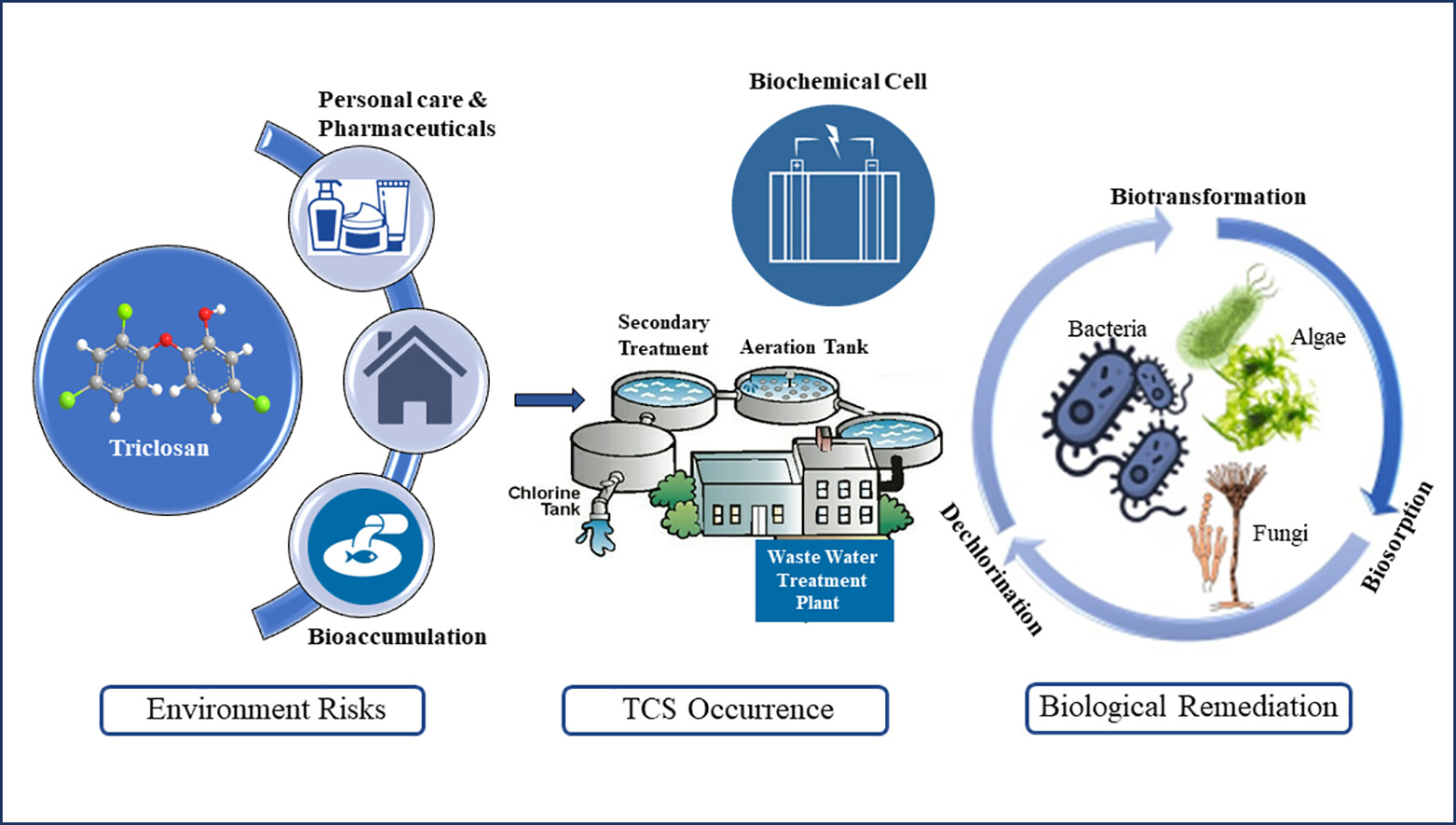Current Happenings ENVS News
- Occurrence, environmental risks, and biological remediation of Triclosan September 16, 2022

The Department of Environmental Science is glad to announce that Assistant Professor Dr Pankaj Pathak and her PhD Scholar Mr Gopa Nandikesh have published an article titled “Occurrence, environmental risks and biological remediation mechanisms of Triclosan in wastewaters: Challenges and perspectives” in the Journal of Water Process Engineering having an Impact Factor 7.34. The paper was published in collaboration with Dr Lakhveer Singh, Sardar Patel University, Himachal Pradesh.
The paper makes a comprehensive understanding of the disadvantages and consequences associated with the excessive use of Triclosan (TCS), an anti-microbial agent widely used in pharmaceutical and personal care products (PPCPs). The article also suggests various ways to achieve the bioremediation of Triclosan using microbial degraders and the different challenges associated with such practices.
The extensive use of TCS in PPCPs has increased over the past few decades, and its sizeable production and consumption are causing adverse effects on the environment and humans. TCS has been made into the list of emerging micropollutants (EMPs) due to its omnipresence in water resources and even in biological samples such as urine and breast milk. Therefore, it is imperative not only to understand the current status of TCS pollution but their occurrence, exposure routes, and environmental risks to identify remediation technologies for mitigating TCS.
Their research targets to provide cumulative data on the abundance of emerging TCS in water resources and its associated health burdens simultaneously. It is identified that TCS remediation can be achieved through advanced physical and chemical methods such as enzyme oxidation and ozonation. However, there are drawbacks such as high energy consumption and the formation of toxic by-products.
The article endeavours to provide an in-depth understanding of the biological remediation of TCS by microbial degraders as well as its superiority over other remediation techniques. Insights into the various microbial communities such as bacteria, algae, and fungi and their unique bioremediation mechanisms are comprehensively summarised. Moreover, challenges associated with existing bioremediation methods and future perspectives are also discussed in the present work.
Continue reading → - Modified solar air heater for preserving agricultural produce September 5, 2022

There is a growing demand for decentralised systems that use renewable energy to extend the shelf life of agricultural commodities. Solar Air Heating systems (SAHs) are effective and environmentally friendly systems used to preserve agricultural produce by lowering the moisture content. Assistant Professor Dr Karthik Rajendran and his Post-Doctoral Scholar Dr VS Vigneswaran from the Department of Environmental Science have published their paper “Augmented v-corrugated absorber plate using shot-blasting for solar air heater – Energy, Exergy, Economic, and Environmental (4E) analysis” in the Q1 journal “Process Safety and Environmental Protection” having an Impact Factor of 7.9. The paper was published in collaboration with D. Sung Chul Kim, Shandong University, China.
South Asia is home to the majority of the world’s hungry people. Among 116 nations, India, the second-most populated nation in the world, is ranked 101st in the global hunger index. There is cause for concern given that India loses over 67 million tonnes of food annually, which is equivalent to about Rs. 92,000 crore. In 2016, the Indian Council of Agricultural Research estimated that during harvest, post-harvest, processing, and storage, about 4.3-6.1% of pulses, 3.9-6% of grains, 2.8-10.1% of oilseeds, 6.9-13% of vegetables, and 5.8-18.1% of fruits were lost. 16% of fruits and vegetables as well as 10% of oilseeds, pulses, and cereals were lost in India due to inadequate access to storage facilities.
Each year, these losses increase in India. In order to reduce food wastage after harvest and the amount of people going hungry in India, technologies must be developed to extend the shelf life of agricultural produce. The utilisation of land, water, energy, and the release of greenhouse gases into the atmosphere can all be decreased by reducing postharvest loss. It is necessary to develop a decentralised system that uses renewable energy to extend the shelf life of agricultural products. Given that the majority of India has abundant solar energy resources, solar crop dryers based on solar air heaters (SAH) are a practical choice for conserving agricultural output by lowering its moisture content. These technologies are appealing because they are affordable and sustainable.
The performance of SAH is determined by the absorber plate. Thus, the SAH was modified with a v-corrugated absorber plate with a shot-blasted surface, and the SAH performance was investigated experimentally. Performance parameters including the energy and exergy efficiency of the collector were determined and compared with those of the conventional SAH. The study inferred that SAH optimisation will make way for the maximisation of its efficiency.
Abstract of the Research
Need for increasing the shelf life of agricultural produce using renewable energy-based A decentralized system are significantly increasing. The solar air heating systems (SAHs) are efficient and environment friendly systems which are used for preserving agricultural produce through the reduction of moisture content. However, these systems had poor thermal efficiency and the way for increasing the efficiency are much need in the present era. This article presents the energy, exergy, and economic analysis of a modified solar air heater system (SAH). The proposed (modified) SAH has a V-corrugation absorber plate; the inner surface was modified using shot-blasting technology. This is the first study to experimentally investigate a modified SAH and compare the results with those of a conventional SAH. Additionally, an environmental and sustainability assessment of the SAH is presented. The SAH performance was tested at airflow rates ranging from 0.01 to 0.02 kg. sec.
Continue reading →

